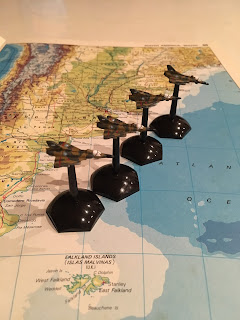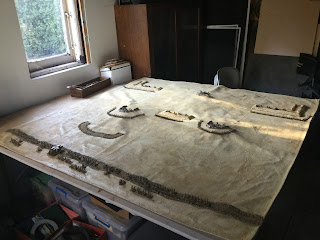Fields of Blue & Grey by Dan Abbott are a set of American Civil War war-gaming rules for fighting up to Corps sized battles with a regiment being the smallest maneuver unit. Abbott notes that "Ground scale is 1 inch = approx 50 yards and the players are meant
to be divisional and corp commanders, instead of brigadiers."
Abbott's rules seek to emphasise command and control game mechanics. Brigades are given orders by Division (and Corps) commanders at the beginning of the game and these can be changed under certain conditions. Brigade commanders can also request an order change by sending a messenger with a status report to his superior.
The combat mechanism is fairly simple based around opposing d6 rolls modified by the presence of leaders, terrain, the level of fatigue of the brigade and morale. Combat losses are essentially reflected by a build-up of fatigue at the Brigade level each time a regiment is in action. As the fatigue level of the Brigade increases it can effect the combat factor of the unit (called its 'volume of fire') and the morale status.
I used an older version of the rules (attached as a PDF at the bottom of the page linked to above) win which Brigades (and divisions) must pass a morale test every turn. A 2012 update moves away form Brigade and Division morale checks. Instead, the units fatigue and morale impact on the brigade's capacity to activate each turn.
Overall, I feel the first use of these rules gave an interesting game and I really liked the 'orders' mechanism and the inevitable consequence of the build up of fatigue. The impact of sustained combat on brigades is well modeled by the fatigue rules - a nice touch. I felt it gave quite a good 'feel' for the challenges faced by brigade and divisional commanders during the Civil War.
As a first time player, I did find the occasional situation where the rules were not explicit. For example, it was not clear on the difference between mounted an dismounted cavalry (except a reduction in movement for dismounted).
One of the difficulties I had was around understanding the impact of varying morale levels (disordered, shaken, beaten) on game play. Again, I believe this is addressed by the new activation system. There was a bit of record keeping (orders, morale status, commander ability and troop quality) but with a little planning and some more subtle on-board counters and a simple roster sheet, it would be handled easily.
 |
| Example of some of the on-board counters that I used. The Litko skulls record the build-up of fatigue. Cardboard counters note the morale status of the unit/brigade. I used a Litko skull on a red base to show when a brigade commander is killed (they are replaced with a commander of lesser ability after 1 full turn. The red Litko 'cross hairs' mark a brigade commander that is wounded. I'll work on reducing the visual impact of these for future games. |
Here are a few images of the first battle I fought using my 2mm Irregular ACW forces. The scenario was sent early in the war and saw the Confederate forces (top of board) pursuing a Union infantry brigade that had retreated from an earlier fight. The Union commander had some support (cavalry, sharpshooters and artillery) hurrying in from the bottom of the board to reinforce the line.
 |
| The Union 1st Brigade holds the open ground NE of a village (let's assume the top of the image is north) having fallen back in good order from a previous engagement. A column of union artillery (2 batteries) and cavalry regiment enter from the SW. Union sharpshooters hold the hill on the Union left flank. |
 |
| Brigadier General Tyndale's Brigade deployed in line of battle with a small reserve and his right flank holding the heights. |
 |
| From the SE, elements of Anderson's Brigade pursue the remnants of a Union division that fell back after an action that earlier that morning. |
 |
| From the SW, Brown's Brigade march quickly to deploy in the open ground to the south of the Union position. Brown's men are fresh having been in reserve during the morning's action. His men are still in column having marched hard to keep pressure on the retreating Union troops. |
 |
| The Union relief column cross the stream and the cavalry swing wide on the left flank. Tyndale's Brigade has hold orders while the cavalry and artillery have orders to advance to Tyndale's left flank and hold. |
 |
| The Confederates deploy into line. The final advance begins. |
 |
| Tyndale's Brigade have rifled muskets so get the first volley in as the Confederates close on their line. |
 |
| The Union troops are spooked as the Rebs advance and their musketry has little impact. |
 |
| The Confederate line advanced to musket range (being armed with smooth bore muskets) and loose the first volley in return. The Union sharpshooters march down into the woods on Tyndale's left to deal with the Confederate overlap. they are elite troops and hold their own! |
 |
| The musketry of the Confederate left flank finds its mark and the forced a Regiment back over the crest of the hill. On the Union left, the artillery unlimbers at the foot of the hill. |
 |
| The musketry over the next couple of rounds takes a toll on the Brigade commanders. Tyndale is out of action for a full turn. The Confederate Brigadier, Anderson, is shot from his horse and falls to the ground, dead. |
 |
| The lines of infantry continue to hammer each other with lead as the fatigue (white skulls) builds up. The intensity of the musketry from the Confederate left drives back yet another Union regiment. On the left, the Union cavalry seeks to take the mill on the Confederate right flank. Anderson's cavalry (dismounted) forms a line in front of the mill and holds firm! |
 |
| The last remaining Union regiment has to fall back under sustained fire from the Confederates. |
 |
| The Confederate advance falters on their left with a regiment driven back form the hill-top. Moral on both sides is beginning to falter. Both sides are now shaken but the Confederate advance pushes on. |
 |
| The Union cavalry assault on the left fails. The Union morale falls again - Tyndale's Brigade is battered! |
 |
| Finally, the union artillery opens fire on the second Confederate line on the right flank and yet another Confederate Brigade commander falls! However, sensing the Union troops are nearly spent, a yell springs up from the Confederate line on the right and they charge into the woods to clear out the Union sharpshooters. |
 |
| A Change of orders on the Confederate right redirects their attack towards the undefended artillery. Brown's Brigade (Confederate left) keep up the musketry on the Union troops that have now fallen back to the stream. |
 |
| On the Confederate right flank, Anderson's cavalry push forward. Both sides have been contact for a couple of hours now and exhaustion is setting in. Ammunition is short and morale sits on a knife edge! Anderson and Brown know that all they have to do is keep pressure on the Union troops and they will break soon. |
 |
| The Union Brigade commander on the left is still out of action having been wounded in the melee in the woods. The Union forces have been battered but are not yet defeated. This is where the action concluded, without a clear victory for either side (although, definitely advantage to the Confederates). I expect another turn or two of Confederate musketry might have tipped the balance in their favour. |













































































